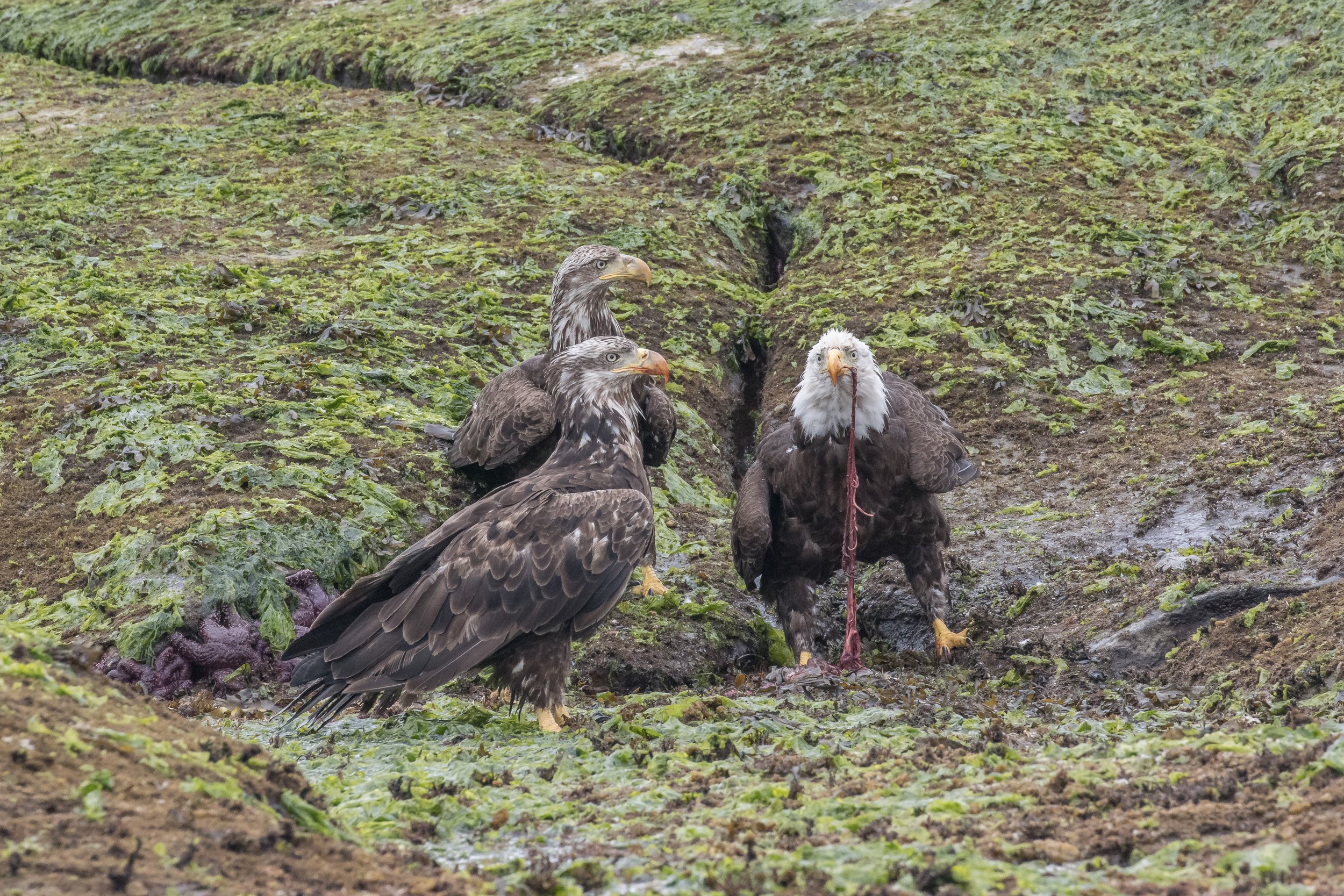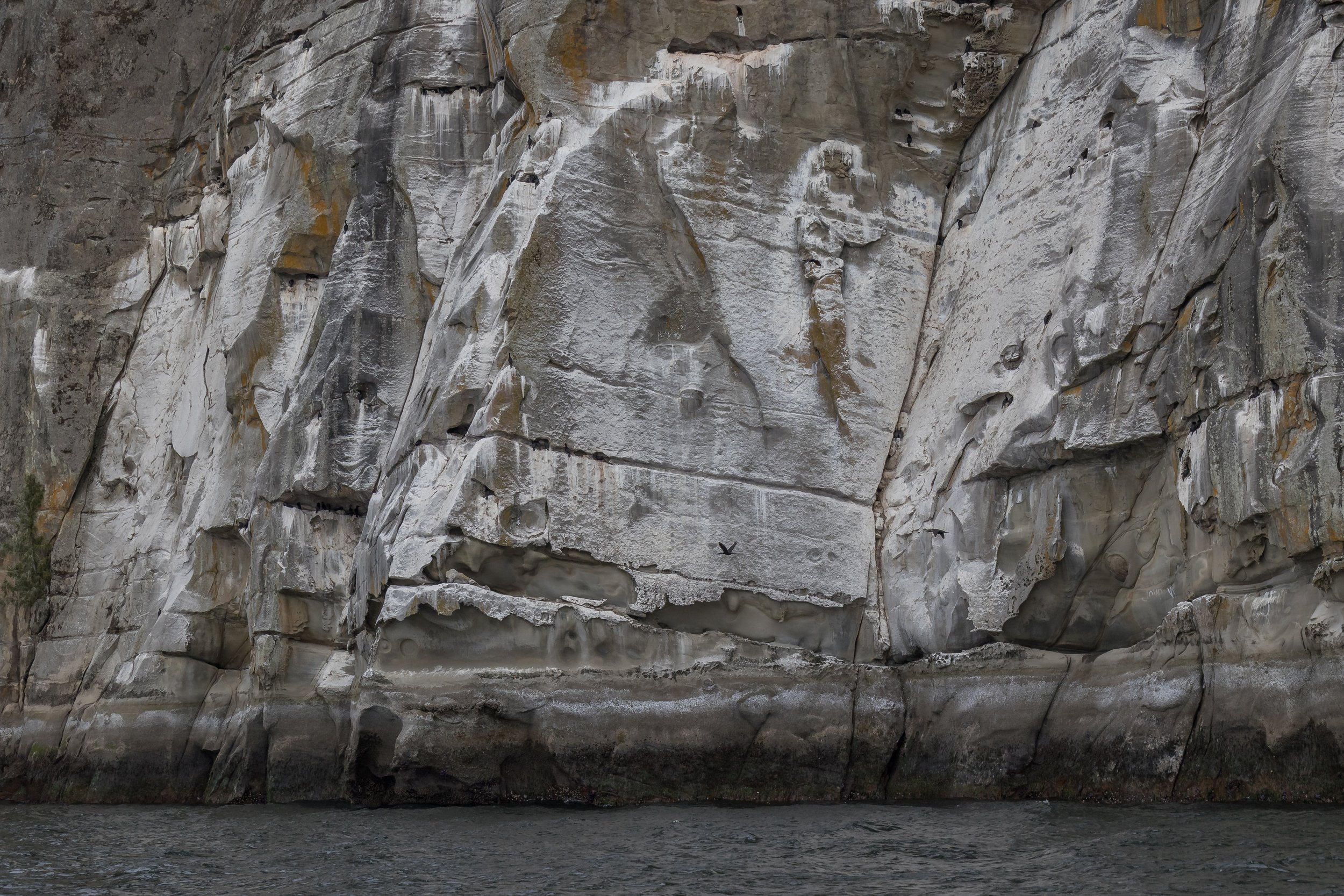August 2, 2023 - Humpback Hangouts and an Eagle Extravaganza!
10:30 am:
It was another great day spent with whales in the Strait of Georgia. On the morning tour we headed over towards a popular whale spotting area known as Halibut Bank. This area is a biodiversity hot spot, due to the raised ocean floor that gives the area it’s name. This causes water to be pushed closer to the surface, mixing the water column and introducing nutrients that might otherwise be lacking. These nutrients are used by plankton to grow, and that’s what draws the rest of the animals here!
Arriving at the area we spotted some blows off in the distance; Humpback Whales! With so many animals in the area, different boats sometimes come across different animals when travelling, and that’s exactly what happened today! Kula, our semi-covered vessel spotted two well known whales to us, Ocular BCX1705 and Schooner BCX1193 calf 2021. These two hung around each other for a little while, and then eventually went their separate ways. Meanwhile, our open boat Cascadia found two other humpbacks, Beak/Nuage BCX1606 and an unknown whale. While we try to ID all our animals in the field or back at the office, sometimes it just can’t be done! To ID a humpback, we try to get a nice clear shot of the underside of the fluke, which is highly identifiable based on coloration and scar patterns. If we don’t get a picture of the tail, sometimes we can ID an animal based off of the shape of the dorsal. But, on some days (like today), we don’t get clear photos of either, so they remain a mystery.
However, we soon saw some MORE blows in the distance and decide to investigate. It’s always a great day when we can bounce from whale to whale! Coming on scene, we saw the incredibly distinctive fluke of Zorro BCX0380. Take a peek at the pics below to see what we mean; there’s no missing this guy, even if we don’t get a photo! But he wasn’t alone, and soon saw a much tinier dorsal emerge from the water: a small 2023 baby belonging to Europa BCX0854. This little one is the definition of a bouncing baby, with us seeing lots of action from this little one, including some tail slaps, rolling around, and even some breaching! After a bout of activity, Europa and her little one were travelling pretty closely with Zorro, doing small circles and generally milling about.
Once we had our time with the whales, we headed over to stinky rocks to see what other wildlife we could find. And boy did we get SPOILED. We spent some time with our vocal Stellar Sea lions, then went over to see the many Harbour Seal pups that are out right now. As we came around the corner we noticed something unusual, a huge swarm of Turkey Vultures circling and perched on the rocks. Looks like it was lunchtime! As we got closer, we saw not one, but THREE Bald Eagles fly in to get a better look. A buzz of activity broke out, with one Eagle repeatedly calling out in excitement. We knew we had to get a better look and tried to see what all the fuss was about.
CONTENT WARNING: GORY photos and description of events.
Upon closer inspection, a single eagle was nestled in the rocks, feasting on a slew of intestines while the other birds chittered on nearby, hoping for leftovers. While the single eagle feasted on “spaghetti like” bowels, he was quickly joined by two juveniles, who flew in trying to get a piece. These birds were magnificent, clearly transitioning to their adult feathers, as they were fully speckled with white and brown plumage. It was a remarkable sight to watch, and was truly nature in its prime. For the raptor lovers, check out the pictures below. Be warned, some images contain blood and guts.
It was a phenomenal way to end the morning tour!
3:30 pm:
In the afternoon, we headed back out to see what else we could find. While a bit breezier than the morning, we headed back out to the strait. Just SE of Sechelt, we found our second mother-calf pair for the day. This time, it was Zig Zag BCX1193 and her 2023 calf. These two were hanging out in the waves, just enjoying the good food out in this area of the strait!
Zig Zag is an interesting lady. Most of the whales that frequent are incredibly regional, tending to return to the same area year after year. That means that, typically, you won’t find the same animals on the northern tip of the island hanging out in the southern tip, or animals that frequent the Georgia Strait in the offshore waters of the western coast. While mixing between northern and southern regions is beginning to become more frequent, the general trend stays the same. Not Zig Zag though! She has been reported as far north as Quadra Island, as far south as Port Angeles, and has even been spotted in Vargas Island Provincial Park off Tofino. What a range!
After spending some time in the waves, we headed back into the safety of the Gulf Islands and headed to our favourite spot, stinky rocks. Our time with the Stellar Sea lions is always lovely, and we got to see some pretty tiny Seal pups today as well! After winding back through the Gulf Islands, we made one final stop at the Gabriola Bluffs to see the Cormarants.
Pictures by Marine Naturalists Des Poier, Vanessa Vereschahen, and Cheyenne Brewster.
Beak lifting his tail preparing for a low fluking dive! Photo by Des Poier. 10:30 am
Beak going under! Photo by Des Poier. 10:30 am
See that white marking in between beaks flukes? That’s the main identifier for Beak when we see his tail as well as the fluke outlines! Photo by Des Poier. 10:30 am
View of the front of Beaks fluke, a few acorn barnacles on the sides of his tail. Photo by Des Poier. 10:30 am
Beak slipping under the surface usually they will resurface within 4- 7 minutes however humpback can hold their breath for up to an hour. Photo by Des Poier. 10:30 am
Left Zorro and on the right Europa, synchronized diving! Photo by Des Poier. 10:30 am
Zorro (left) and Europa (right) matching flukes, going for a high fluking dive! Photo by Des Poier. 10:30 am
Notice how part of Zorro’s (Left) fluke is missing? Not a very difficult spot the difference with Europa on the Right. Photo by Des Poier. 10:30 am
Zorro in the back with the distinct curved dorsal, Europa in the middle and Europa’s calf closest. Photo by Des Poier. 10:30 am
Mother harbour seal kissing her pup! Photo by Des Poier. 10:30 am
The Bald Eagle making the Turkey Vulture wait their turn as they get first dibs. Photo by Des Poier. 10:30 am
Bald Eagle seems worried we want his meal! Photo by Des Poier. 10:30 am
The majestic Bald Eagle caught red-taloned! Photo by Des Poier. 10:30 am
Two adult bald eagles and one juvenile, all want a piece of the action! Photo by Des Poier. 10:30 am
Two juvenile bald eagles and one fully grown eagle having a meaty spaghetti! Photo by Des Poier. 10:30 am
A group of ochre sea stars these are the purple and beige sea stars on the rocks. This sea star species actually has a lot of colour variation for class Asteroidea. Photo by Des Poier. 10:30 am
Cormorant adult doing a fantastic parenting job as usual. Photo by Des Poier. 10:30 am
Ocular coasting along just offshore. Photo by Cheyenne Brewster.10:30 am
Zorro’s Dorsal standing out on the flat water! Photo by Cheyenne Brewster. 10:30 am
Europa going for a dive. Photo by Cheyenne Brewster.10:30 am
Europa showing off her tail as she shows us a high-flaking dive. Photo by Cheyenne Brewster. 10:30 am
Zorro’s half tail as they copy suit and follow Europa! Photo by Cheyenne Brewster. 10:30 am
Europa and her calf travelling side by side! Photo by Cheyenne Brewster. 10:30 am
Europa and calf in front of Zorro who’s coming up for a breath! Photo by Cheyenne Brewster. 10:30 am
Europa diving with her calf behind Zorro! No wonder there called humpbacks! Photo by Cheyenne Brewster. 10:30 am
Steller Sea Lions Lounging on the rocks! Photo by Vanessa Vereschahen. 10:30 am
See that white colour on the rocks? Thats cormorant fees and it’s so acidic it can kill vegetation! Photo by Vanessa Vereschahen. 10:30 am
Zig zag’s fluke in rougher weather! Photo by Des Poier. 3:30 pm.
A sliver of Zig zags dorsal submerged in the waves! Photo by Des Poier. 3:30 pm.
High tide for the Steller Sea Lions! Photo by Des Poier. 3:30 pm.
Steller Sea Lion usually are found in these larger groups, safety in numbers when the orcas are out to get you! Photo by Des Poier. 3:30 pm.
A female Steller sea Lion scooting along what’s left of the rocky island. Photo by Des Poier. 3:30 pm.
Two harbour seals soaking up what’s left of the sun’s rays! Photo by Des Poier. 3:30 pm.
Steller Sea Lions swimming in the Salish Sea! Photo by Des Poier. 3:30 pm.
The Steller Sea Lions poking their faces out of the water and waving their flippers in the air. Photo by Des Poier. 3:30 pm.
Steller Sea Lions may have been a bit spooked as they slip under the water. Photo by Des Poier. 3:30 pm.
Can you spot the juvenile Gull on the rock? Before gulls are fully grown they have gray coloration to help blend into their nest sites. Do you think it worked? Photo by Vanessa Vereschahen. 3:30 pm





































